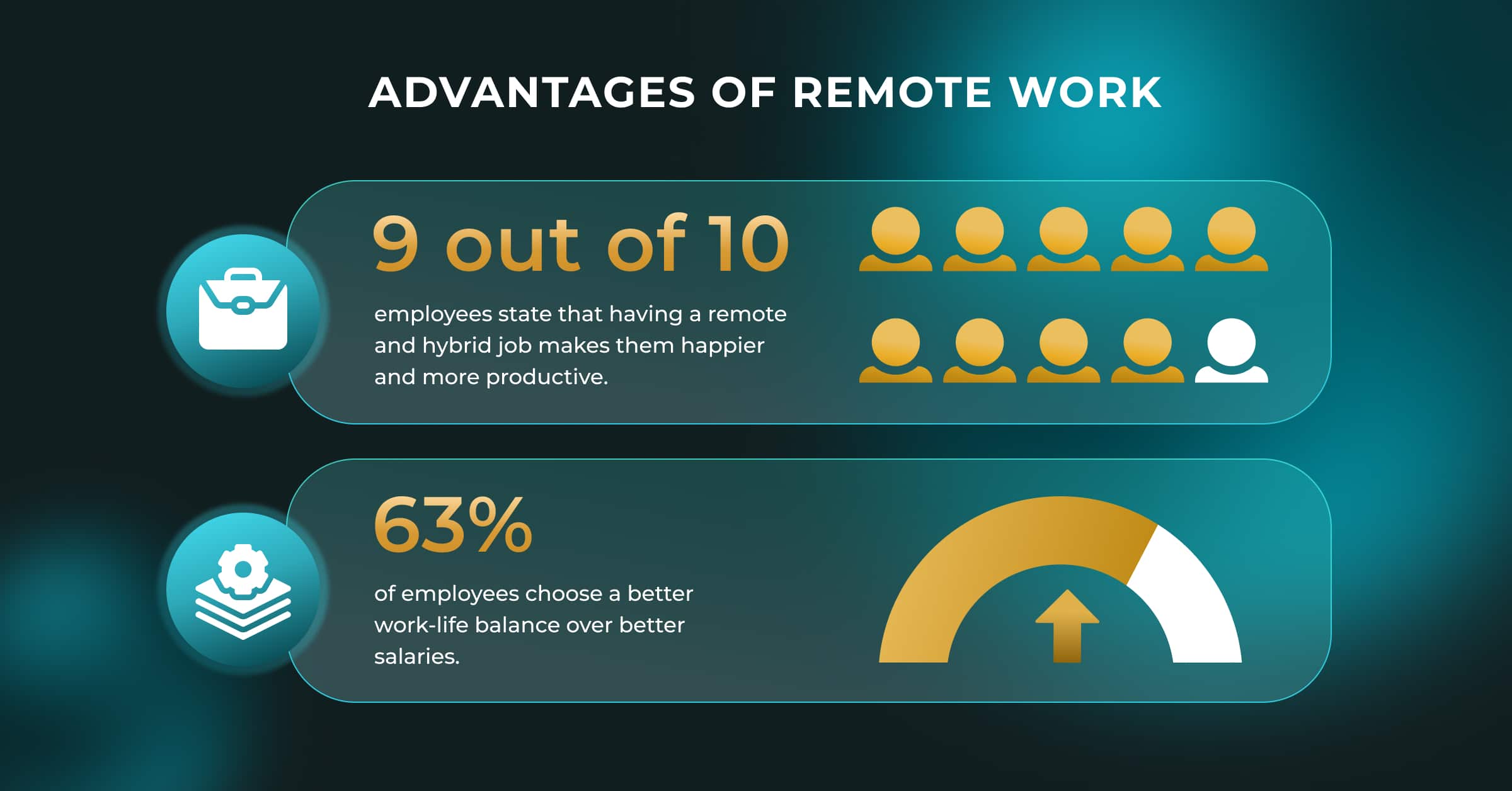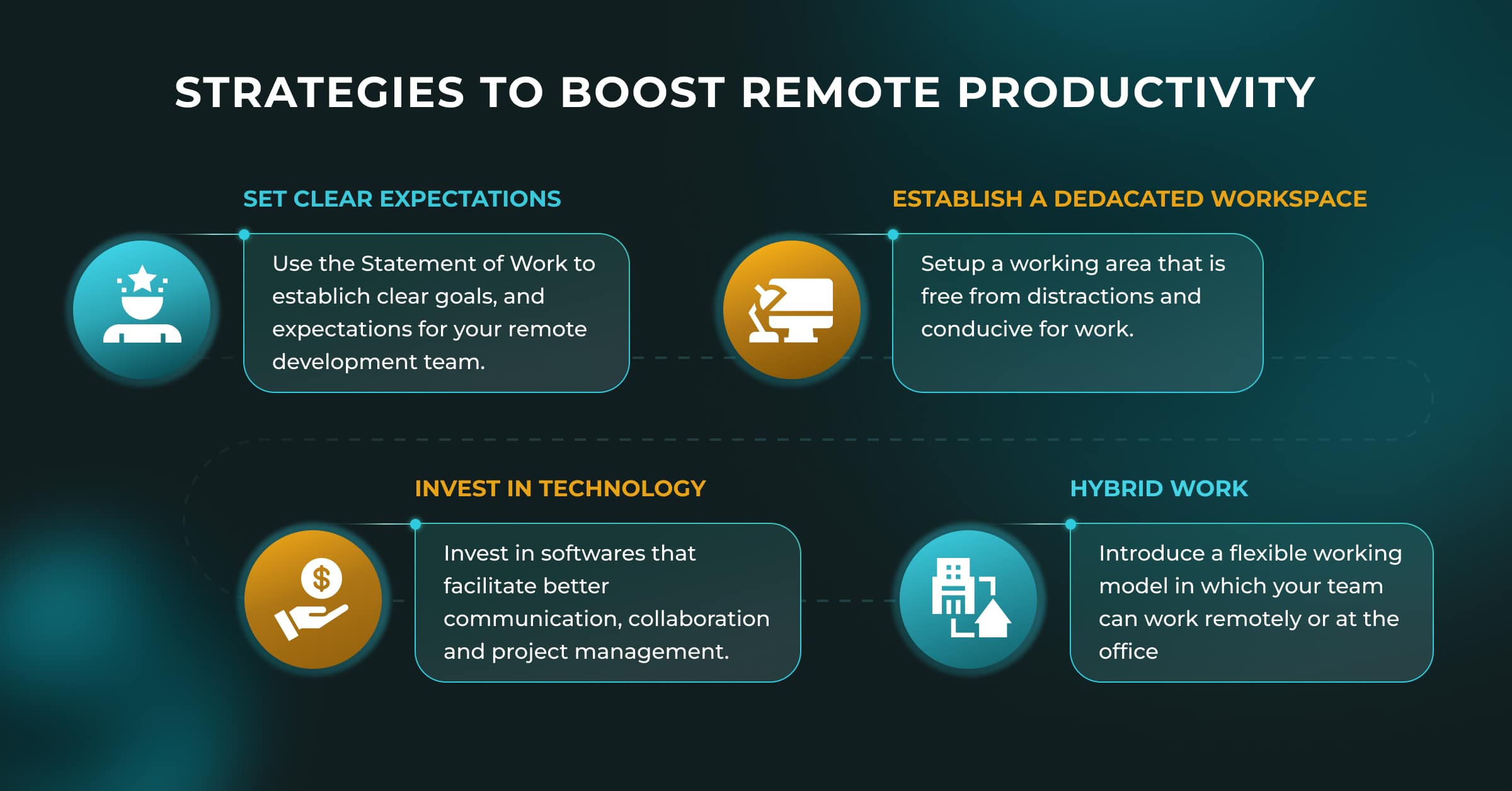How To Boost Productivity in a Remote Development Team: Best Practices
The employment sector has undergone a massive revolution over the last few years. This is because of the rise of remote and hybrid work arrangements as preferred modes of employment. Remote work offers staff the freedom to work from locations of their choice.

However, while flexible and convenient, this work model has challenges that may reduce remote team productivity. A survey in the US and UK found that over 50% of participants felt remote working made them feel disconnected from their teammates. This disconnection led to communication problems with their colleagues.
Challenges like these significantly impact remote workforce productivity but can be resolved. This article will explore strategies to overcome any obstacles that affect productivity in your remote development team. Dive in to learn more.
Pros & Cons of Remote Work
Virtual work is appealing because it offers employees freedom. However, like every major revolution, it has advantages and disadvantages that must be carefully considered.

Pros
Increased Productivity
Without the distractions of the conventional office environment, remote and hybrid workers say that they can reach work targets more efficiently. Out-of-office employees can create workstations and environments that match their preferences and needs. Thus, remote workers often have a better work-life balance.
This leads to increased job satisfaction and motivation. Happy employees are also less likely to leave their jobs. The advantage is reduced staff turnover and associated costs. 84% of the 4000 professionals surveyed by Flexjobs stated that the option to sometimes work outside the office makes them happier and more efficient.
Better work-life balance
A better work-life balance improves the productivity of remote workers. One survey of 4000 professionals found that 63% of them chose a better work-life balance over better pay. When a remote development team is not tied to a physical space, they can structure their days in a way that serves them best. This gives them more time for their personal lives, including family commitments and social engagements.
Flexibility
With telecommuting, workers are not tied down by the rigid 9 – 5 routine. Remote work allows your development team to design their schedules to fit their work styles and increase team productivity. They can choose where to work from home, a cafe, or while traveling as digital nomads. Fortune 500 companies like Lyft have embraced the flexible workplace. They offer workers a flexible model that supports remote work in which teams can work from home or the office.
Cost Savings
A virtual work model allows companies to reduce or eliminate office space altogether. With virtual work, companies can reduce expenses associated with leasing or owning office space, including rent, utilities, maintenance, and furnishings. IBM saved $50 million in real estate costs by integrating remote work. The company vacated more than 58 million square feet of office space and drastically reduced lease expenses.
Remote work also helps your employees achieve significant cost savings. By eliminating daily commutes, they save on transportation expenses such as gas, public transportation costs, and parking fees. Preparing meals at home instead of purchasing food from restaurants or cafes will save dining expenses.
The flexibility of telecommuting reduces spending on professional attire and dry cleaning. For parents, remote work can save childcare costs, as they can care for their children at home more flexibly. Moreover, some remote workers may choose to relocate to areas with more affordable housing options.
Cons
Loneliness
For some people, working from home can be a lonely experience. According to Forbes Advisor, 53% of workers feel disconnected from the office environment. The lack of in-person interactions may increase feelings of loneliness and isolation. The virtual workers miss the casual coffee break chats and office gossip between colleagues.
Also, 41% of remote workers reported feeling stressed, compared to only 25% of office workers. This can impact morale and overall job satisfaction. Regular welfare meetings and catch-up sessions are crucial to prevent feelings of isolation and disconnection.
Blurred Boundaries
People who work outside the office tend to experience difficulty separating work and personal life compared to regular office workers. With a clear boundary between work and home, remote workers may find it easier to disconnect from work. Additionally, 42% of remote workers experienced trouble sleeping, while only 29% of office workers faced the same issue.
Career Stagnancy
In-person networking is crucial for career advancement. Sometimes, virtual workers miss out on lucrative in-person networking opportunities. They may feel overlooked or undervalued compared to their in-office counterparts. Virtual workers feel they are less visible and receive fewer opportunities for career advancement or recognition.
Technical Issues
Remote work is 100% reliant on technology. This means technical issues such as internet outages or software glitches can disrupt remote work and productivity, cause frustration, and make communication more difficult.
Time Difference Challenges
Differences in time zones impact scheduling, communication, collaboration, and overall team dynamics. Managing a remote development team across different time zones requires compromise and often leads to inconvenient early-morning or late-night sessions for some team members. Communication delays are common, as responses to emails and messages may be delayed because of differences in work hours. This slows down decision-making processes and workflow efficiency.
Strategies to Boost Productivity
If you are wondering, “How to improve team productivity for my remote team?” below are some effective strategies that will undoubtedly make a difference.

Set Clear Expectations
Setting clear goals and expectations for your remote team maximizes remote productivity. This is achieved by establishing the Statement of Work (SOW).
The SOW is a foundational document that establishes clear expectations and requirements for the work to be performed, ensuring alignment and accountability between the parties involved. It typically includes detailed descriptions of the project scope, including specific tasks or activities to be completed and any assumptions, constraints, or dependencies that may affect the project.
Establish a Dedicated Workspace
Distractions come up in the remote work environment. Employees should proactively minimize distractions by establishing boundaries with family members or roommates and muting unnecessary notifications. Project managers should also invest in productivity tools like website blockers.
Additionally, encourage your employees to create a designated workspace. This space should be free from distractions and conducive to focus. Be it a home office, a corner of the living room, or a cozy cafe, having dedicated space signals to the brain that it’s time to work and helps establish boundaries between work and personal life.
Use the Pomodoro Technique
Consider implementing the Pomodoro Technique in your operations. Developed by Francesco Cirillo, the Pomodoro Technique involves breaking work into 25-minute intervals (Pomodoros) followed by 5-minute breaks. After completing four Pomodoros, employees must take a longer break of 15-30 minutes. This method helps them manage time effectively. It is also designed to help workers maintain focus and prevent burnout by providing regular breaks. It is particularly useful for tasks requiring sustained concentration or prone to procrastination.
Invest in Technology
Establishing clear communication channels within your remote development team is important. Plenty of productivity tools promote effective remote team working conditions.
Use platforms like Trello and Asana for project management. Utilize tools like Slack and Microsoft Teams for communication. Find the ones that work best for your team and add them to your operations.
Also, consider using time-tracking software like ManageEngine. It will monitor how your team spends their time and help find areas for improvement. Setting regular check-ins and remote meetings can help keep everyone on the same page.
Introduce Hybrid Work
Remote work can sometimes feel isolating. Ensure your workers feel connected to colleagues and managers.
Schedule regular check-ins via video or phone. Use them to discuss progress, share updates, and ask for support. Participate in remote team meetings, collaborative projects, and online groups to foster a sense of belonging and familiarity. Sometimes, this is enough to combat the mental health issues that arise from no interactions with teammates or colleagues.
To combat mental health problems caused by isolation, significant organizations like 3M introduced the “Work Your Way” technique. This technique gave all employees the chance to choose their working model. Employees can choose whether to work in the office, outside the office, or mix both hybrid works.
In a hybrid work setup, employees can work from the office and telecommute part-time. It also has the advantages of both remote and full-time work, like flexibility, less commuting, in-person collaboration, and connection with colleagues.
Examples from Big Companies
Over the past few years, attitudes towards remote work have undergone major transformations. Managers now acknowledge it as a good and even better option for their business. Among them, several industry giants are pioneers in the telecommuting movement. They have set the standard that all other organizations now follow, i.e., flexibility, efficiency, and innovation. Let’s explore some notable examples of big remote work companies leading the way:
GitLab
GitLab, the most comprehensive AI-powered DevSecOps Platform, is one of the largest all-remote companies in the world. From its onset, GitLab fully embraced virtual work. With employees in over 65 countries, GitLab has no central office. Instead, it relies on digital tools and asynchronous communication to connect teams. The organization has a transparent approach to telecommuting, documented in its Remote Work Handbook, which serves as a blueprint for other organizations adopting a similar model.
Buffer
With this social media management software, collaboration has never been easier. Buffer helps teams collaborate on generating and storing ideas, scheduling social media posts, and managing campaigns. The company has integrated teams from over 15 countries operating with a distributed team spread across different time zones. Buffer has gained a reputation for prioritizing employee well-being. It does this with initiatives like the four-day workweek, annual retreats, and a significant transparency culture.
Automattic
Automattic, the company behind WordPress, is another trailblazer in remote work. Automatticians work in over 93 countries and 119 different languages. Automattic has cultivated an outstanding virtual culture rooted in open communication, collaboration, and results. The organization’s remote workforce lets it recruit global talent, which helps it adapt to diverse market demands.
InVision
InVision through Freehand is a one-in-all collaboration platform. It has embraced remote work as a core part of its company culture. Spanning multiple continents, InVision values unlock productivity. It lets teams solve customer problems and make better products. They get faster feedback and broader buy-in. InVision gives employees the tools and support they need to thrive in real-time. This help ranges from remote team-building to thorough onboarding programs.
Conclusion
Remote work is here to stay, but it requires intentional efforts to combat isolation and maintain productivity. By implementing the above productivity hacks, remote team activities can be optimized.
If you need talents that are highly productive, Newxel offers staff augmentation services, helping you to hire experts from any location in the world.
Our team of experienced professionals collaborates closely with you to understand your unique requirements and deliver tailored solutions that drive success.







